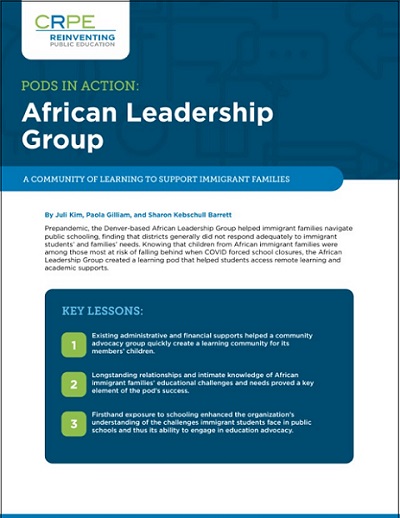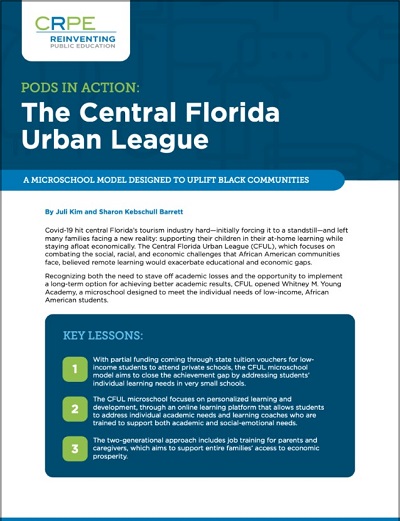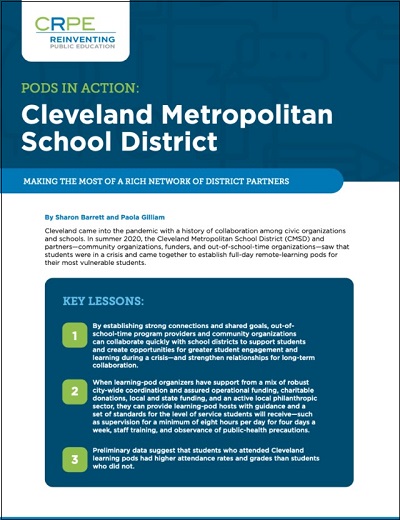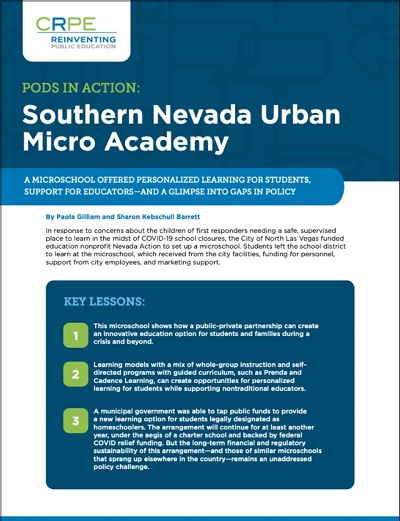Over the past year, Public Impact has worked with the Center on Reinventing Public Education to learn about the innovations that emerged when schools shut down due to Covid, particularly, pandemic pods. In two reports and four case studies, we profile examples of pandemic pods and show the potential for innovation in the current education environment.
“The most professionally satisfied I’ve been.” How could the best aspects of learning pod staffing be scaled up?
Pandemic pods created new opportunities for adults interested in supporting children’s education. In these pods, teachers had the chance to work with much smaller groups of students than usual, specialize in specific aspects of the broader teaching role, work a part-time schedule, and play a lead role in deciding or even creating curriculum. Other adults without formal teaching credentials gained the opportunity to play critical roles, as well, such as providing academic tutoring and social and emotional support to students during a time of great need. Many pod staff members found these new roles appealing.
Pods revealed that teachers and other adults want to play more varied roles in students’ education. And some pod-like staffing arrangements may continue to exist and grow in out-of-school settings, such as after-school programs. But in a new report for the Center on Reinventing Public Education (CRPE), Public Impact Co-President Bryan Hassel examines another potential development: Is it possible that the experiences staff had in pods could become much more common in the day-to-day operations of U.S. public schools, at scale?
The answer is a qualified “yes.” Pre-Covid, some public schools were already creating new staffing arrangements that hit many of the same themes as pods, such as Public Impact’s Opportunity Culture initiative, which has already shown positive impacts on student learning and educator satisfaction and is described in more detail in the report.
Equitable Pandemic Learning Pods? A Glimpse of an Emerging Ecosystem
When Covid forced students to learn from home in spring 2020, families were left largely on their own to figure out how to fill the gaps in school structure and supports, leading to the emergence of learning pods.
Some of these small learning communities continued into fall 2021, either because of continued pandemic uncertainty or because of their potential value as part of a new structure for public education.
What supports could make it possible for learning pods to continue?
In Equitable Pandemic Learning Pods? A Glimpse of an Emerging Ecosystem, Public Impact, in collaboration with the Center on Reinventing Public Education, maps the ecosystem of organizations needed to support a small subset of these learning communities, highlighting the roles these organizations played and challenges they faced.
Case Studies: Pods in Action
In spring 2021, Public Impact interviewed staff, families, and community members who participated in pandemic pods to learn more about the strengths and future of these innovations.
African Leadership Group
Pre-Covid, the Denver-based African Leadership Group helped immigrant families navigate public schooling, finding that districts generally did not respond adequately to immigrant students’ and families’ needs. Knowing that children from African immigrant families were among those most at risk of falling behind when Covid forced school closures, the group created a learning pod that helped students access remote learning and academic supports.
The Central Florida Urban League
The Central Florida Urban League (CFUL), which focuses on combating the social, racial, and economic challenges that African American communities face, believed remote learning would exacerbate educational and economic gaps. Recognizing both the need to stave off academic losses and the opportunity to implement a long-term option for achieving better academic results, CFUL opened a microschool designed to meet the individual needs of low-income, African American students.
Cleveland Metropolitan School District
Cleveland came into the pandemic with a history of collaboration among civic organizations and schools. In summer 2020, the Cleveland Metropolitan School District and partners—community organizations, funders, and out-of-school-time organizations—saw that students were in a crisis and came together to establish full-day, remote-learning pods for their most vulnerable students.
Southern Nevada Urban Micro Academy
In response to concerns about the children of first responders needing a safe, supervised place to learn in the midst of Covid-19 school closures, the City of North Las Vegas funded education nonprofit Nevada Action to set up a microschool. Students left the school district to learn at the microschool, which received from the city facilities, funding for personnel, support from city employees, and marketing support.






